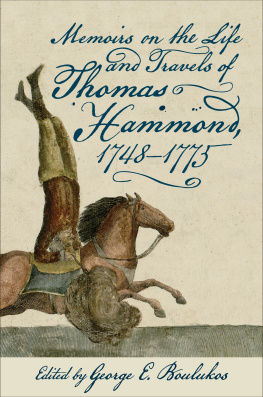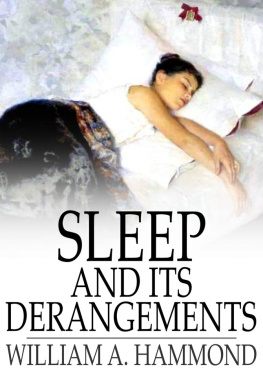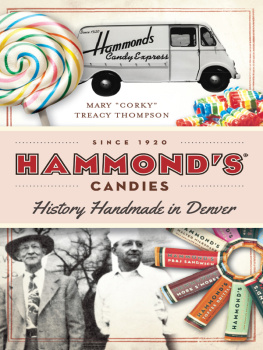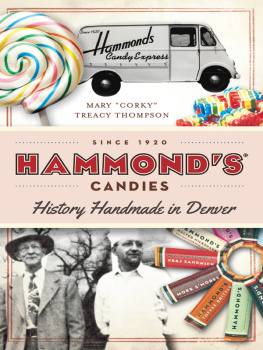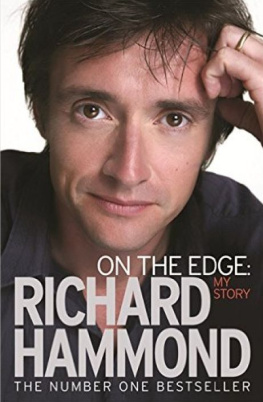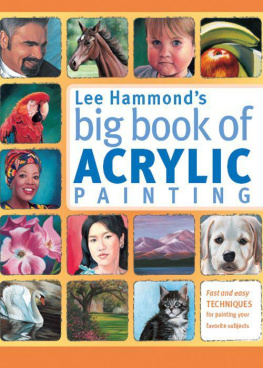Memoirs on the Life and Travels of Thomas Hammond, 17481775
Edited by George E. Boulukos
University of Virginia Press Charlottesville and London
University of Virginia Press
2017 by the Rector and Visitors of the University of Virginia
All rights reserved
Printed in the United States of America on acid-free paper
First published 2017
9 8 7 6 5 4 3 2 1
Library of Congress Cataloging-in-Publication Data
Names: Hammond, Thomas, 1748approximately 1824, author. | Boulukos, George, editor.
Title: Memoirs on the life and travels of Thomas Hammond, 17481775 / edited by George E. Boulukos.
Description: Charlottesville : University of Virginia Press, 2017. | Includes bibliographical references and index.
Identifiers: LCCN 2016055630 | ISBN 9780813939674 (cloth : acid-free paper) | ISBN 9780813939681 (e-book)
Subjects: LCSH: Hammond, Thomas, 1748approximately 1824. | Hammond, Thomas, 1748approximately 1824TravelEurope. | OrphansEnglandBiography. | StablehandsEnglandBiography. | JockeysEnglandBiography. | Working classEnglandBiography. | Circus performersEuropeBiography. | Trick ridingEuropeHistory18th century. | EuropeDescription and travel. | EuropeSocial life and customs18th century.
Classification: LCC CT788.H273 A3 2017 | DDC 940.2/53092 [B]dc23
LC record available at https://lccn.loc.gov/2016055630
Frontispiece: Title page with medallion of Hammond from the English version of volume 1.
Cover art: One of a series of copper plates showing an eighteenth-century trick-riding performance, pasted by Thomas Hammond into the original manuscript of the Memoirs.
Thomas Hammonds memoirs and all illustrations unless otherwise noted are published by permission of the Harry Ransom Center, The University of Texas at Austin.
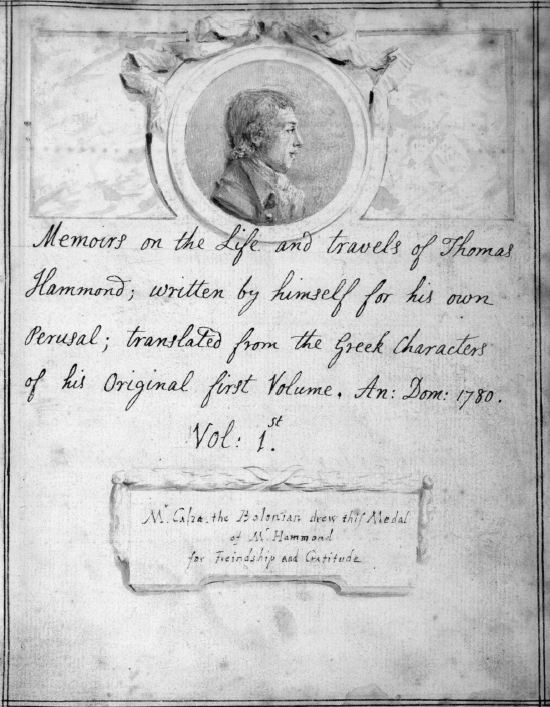
Dedicated to my mother and father, Carol Snyder Boulukos and Athanasios Boulukos
Illustrations
Volume 1
Volume 2
Acknowledgments
This edition of Thomas Hammonds Memoirs has been centuries in the making. Hammond himself finished his work on the text about 230 years ago. However, I have been working on the present edition myself for twenty-five years, whereas Hammond may have spent only a decade or so writing and illustrating his versions of it. Given the quarter of a century I have put in, I will certainly fail to acknowledge some of those who have contributed, even quite directly, to the project.
To begin at the beginning: Leah Marcus, as my professor for Research Methods in the English Department of the University of Texas at Austin, got the project started by assigning each of us to present a notable manuscript from the Harry Ransom Humanities Research Center to the class. She went on to oversee my work on Hammond in her Textual Studies seminar, and to codirect my masters thesis, which was my first attempt at this edition. Lance Bertelsen was invaluable as the codirector of that thesis project, and as an advisor about the project all along the way.
The members of Professor Marcuss two courses contributed much to the project; I should particularly thank her Textual Studies seminar of Fall 1993 for help in deciphering Hammonds odd Greek cipher, including Professor Marcus herself as well as Joi Chevalier, Mark Womack, Jennifer Huth, Frances Hawener, Morri Safran, Shannon Prosser and Robert Moore. Many thanks to Lisa L. Moore, my dissertation cochair and model of how to be an English professor; to Scarlet Bowen and Jenneken Van Keppel, the greatest dissertation group ever; to Matthew Goldstein, Morri Safran, Robby Sulcer (RIP), and many others at UT Austin during my time as a graduate student there, who made the experience an excellent one; and to Rachel Schneider and Molly OHagan Hardy (among others), who welcomed me back to UT Austin on my return to discuss Hammond there.
The staff of the HRC have been vastly helpful over the years. Unfortunately I failed to take note of everyones names, but I know for certain that Pat Fox, Cathy Henderson, Rich Oram, Rachel Howarth, Rick Watson, and Elizabeth Garver have gone well out of their way to help me. They did everything from guiding me to documentation of well-known eighteenth century circus riders in the HRCs collection on early circus history, to expediting permissions and reproductions (multiple times) over the years and decades.
Special thanks are due to many of my colleagues and students at Southern Illinois University Carbondale. Christopher Weedman, as my research assistant in the English Department for a few semesters, transcribed sections of Hammonds manuscript and reviewed the rest of it carefully. Roy Bearden White read an early state of the manuscript carefully and provided many useful notes. The other members of my seminar on eighteenth century autobiography (English 516, Writing the Self, Fall 2009) provided a stimulating, engaged, and very encouraging session on Hammond and the Memoirs. My undergraduate students in several sections of my English 302B survey (16601900) helped me keep my faith in the project with their enthusiastic reception of Hammond as an eighteenth-century writer who captured what their own experiences of growing up might have been like in his time. The English Department staff has also given me frequent and much appreciated help over these many years, in particular Kathy Reichenberger, Kelly Spencer, Jackie MacFadden, Patty Norris, Robin Adams, Joyce Shemonia, and Bernadette Summerville. I must also, of course, thank the librarians at SIUCs Morris Library, many of whom have always gone out of their way to help. I would like to note in particular Walter Ray in Special Collections, and Steve Sawyer, Marti Kallal, and Tony Bittle at the circulation desk.
Additional thanks to the two faculty writing groups in which I participated at SIUC: Walter Metz, Shannon McDonald, and Andrew Balkansky; and David Johnson, Deborah Burns, and Joe Sramek (and thanks to Jacob Haubenreich for organizing both). Thanks also to Stacey Sloboda, my colleague in eighteenth-century studies at SIUC in the Art and Design department, who I met at ASECS in Montreal; to my excellent group of colleagues studying the British and American eighteenth and nineteenth centuries in SIUCs English DepartmentDavid Anthony, Anne Chandler, Ken Collins, Scott McEathron, and Joe Shapiro; to David and Holly Hurlburt for advice about getting support and navigating bureaucracy at SIUC; and to Ed Brunner and the SIUC OPSA office for help with my NEH application.
The number of eighteenth-century scholars who have offered useful insights and feedback in passing encounters with Hammond at conferences and talks is staggering, and I regret my failure to keep adequate track of all of them. I received a good deal of help and encouragement at the Johnson Society meeting in 2007, particularly from Robert Folkenflick and John Dussinger (and to Stephen Karian, thanks for the invitation). Although I was merely a member of the audience, the panel Editors and Editing of Eighteenth-Century Authors (chaired by Kit Kincade) at ASECS 2013 in Cleveland provided a great deal of help and advice; thanks in particular to E. Joe Johnson. I have presented on Hammond at ASECS twice, on the panel Upstairs, Downstairs: Servants in the Eighteenth-Century at ASECS 2008 in Vancouver, and again on the panel Realism and Real Life: New Approaches to Material Culture and Literature at ASECS Pittsburgh 2016. Both experiences were invaluable to the process. Back in the 1990s, the members of the C-18L listserv helped me greatly with various odd strands of research that Hammond demanded. Thanks also to Eugenia Zuroski Jenkins for a helpful reading and the opportunity to present Hammond to the readers of ECF; and to Nick Paige, Jeremy Popkin, Vin Carretta, William Warner, Deidre Lynch, and Kristina Straub, who each provided crucial scholarly models and were kind enough to give advice and support at various ASECS meetings.

